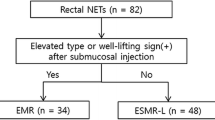Abstract
Background
Conventional endoscopic mucosal resection (EMR) for removing rectal neuroendocrine tumors (NETs) has a high risk of incomplete removal because of submucosal tumor involvement. EMR using a dual-channel endoscope (EMR-D) may be a safe and effective method for resection of polyps in the gastrointestinal tract. The efficacy of EMR-D in the treatment of rectal NET has not been evaluated thoroughly.
Methods
From January 2005 to September 2011, a total of 70 consecutive patients who received EMR-D or endoscopic submucosal dissection (ESD) to treat a rectal NET <16 mm in diameter were included to compare EMR-D with ESD for the treatment of rectal NETs.
Results
The EMR-D group contained 44 patients and the ESD group contained 26 patients. The endoscopic complete resection rate did not differ significantly between the EMR-D and ESD groups (100 % for each). The histological complete resection rate also did not differ significantly between groups (86.3 vs. 88.4 %). The procedure time was shorter for the EMR-D group than for the ESD group (9.75 ± 7.11 vs. 22.38 ± 7.56 min, P < 0.001). Minor bleeding occurred in 1 EMR-D patient and in 3 ESD patients (2.3 vs. 7.6 %). There was no perforation after EMR-D or ESD.
Conclusions
Compared with ESD, EMR-D is technically simple, minimally invasive, and safe for treating small rectal NETs contained within the submucosa. EMR-D can be considered an effective and safe resection method for rectal NETs <16 mm in diameter without metastasis.



Similar content being viewed by others
References
Ellis L, Shale MJ, Coleman MP (2010) Carcinoid tumors of the gastrointestinal tract: trends in incidence in England since 1971. Am J Gastroenterol 105:2563–2569
Kwaan MR, Goldberg JE, Bleday R (2008) Rectal carcinoid tumors: review of results after endoscopic and surgical therapy. Arch Surg 143:471–475
Baek IH (2010) Endoscopic submucosal dissection or conventional endoscopic mucosal resection is an effective and safe treatment for rectal carcinoid tumors: a retrospective study. J Laparoendosc Adv Surg Tech A 20:329–331
Park HW, Byeon JS, Park YS, Yang DH, Yoon SM, Kim KJ, Ye BD, Myung SJ, Yang SK, Kim JH (2010) Endoscopic submucosal dissection for treatment of rectal carcinoid tumors. Gastrointest Endosc 72:143–149
Zhou PH, Yao LQ, Qin XY, Xu MD, Zhong YS, Chen WF, Ma LL, Zhang YQ, Qin WZ, Cai MY, Ji Y (2010) Advantages of endoscopic submucosal dissection with needle-knife over endoscopic mucosal resection for small rectal carcinoid tumors: a retrospective study. Surg Endosc 24:2607–2612
Kang KJ, Kim KM, Min BH, Lee JH, Kim JJ (2011) Endoscopic submucosal dissection of early gastric cancer. Gut Liver 5:418–426
von Renteln D, Schmidt A, Vassiliou MC, Rudolph HU, Caca K (2010) Endoscopic mucosal resection using a grasp-and-snare technique. Endoscopy 42:475–480
de Melo SW, Jr Cleveland P, Raimondo M, Wallace MB, Woodward T (2011) Endoscopic mucosal resection with the grasp-and-snare technique through a double-channel endoscope in humans. Gastrointest Endosc 73:349–352
Jetmore AB, Ray JE, Gathright JB Jr, McMullen KM, Hicks TC, Timmcke AE (1992) Rectal carcinoids: the most frequent carcinoid tumor. Dis Colon Rectum 35:717–725
Scherubl H (2009) Rectal carcinoids are on the rise: early detection by screening endoscopy. Endoscopy 41:162–165
Lee DS, Jeon SW, Park SY, Jung MK, Cho CM, Tak WY, Kweon YO, Kim SK (2010) The feasibility of endoscopic submucosal dissection for rectal carcinoid tumors: comparison with endoscopic mucosal resection. Endoscopy 42:647–651
Wang AY, Ahmad NA (2006) Rectal carcinoids. Curr Opin Gastroenterol 22:529–535
Disclosures
Drs. Wook Hyun Lee, Sang Woo Kim, Chul-Hyun Lim, Jin Soo Kim, Yu Kyung Cho, In Seok Lee, Myung-Gyu Choi, and Kyu Yong Choi have no conflicts of interest or financial ties to disclose.
Author information
Authors and Affiliations
Corresponding author
Rights and permissions
About this article
Cite this article
Lee, WH., Kim, SW., Lim, CH. et al. Efficacy of endoscopic mucosal resection using a dual-channel endoscope compared with endoscopic submucosal dissection in the treatment of rectal neuroendocrine tumors. Surg Endosc 27, 4313–4318 (2013). https://doi.org/10.1007/s00464-013-3050-0
Received:
Accepted:
Published:
Issue Date:
DOI: https://doi.org/10.1007/s00464-013-3050-0




